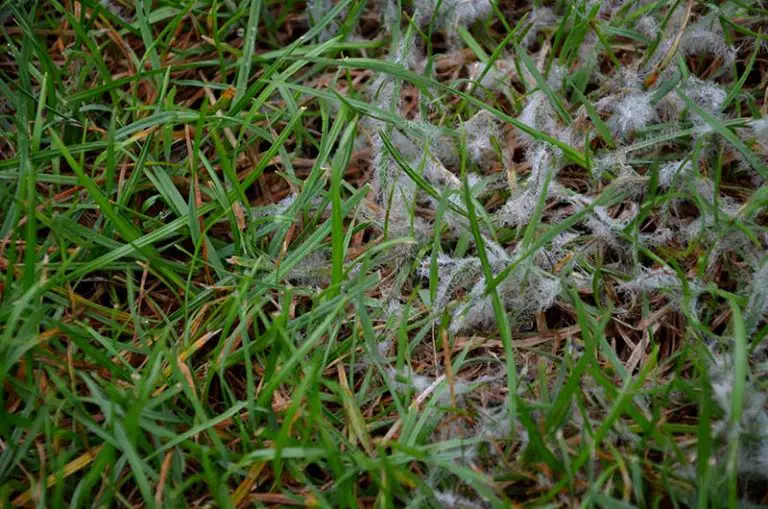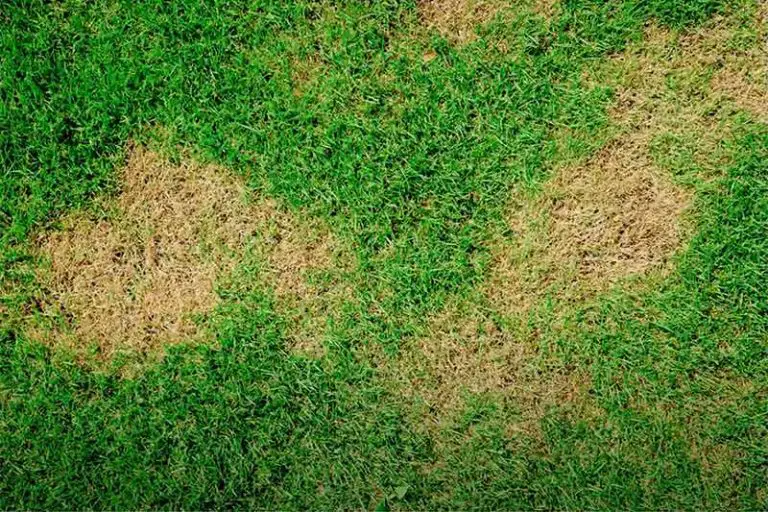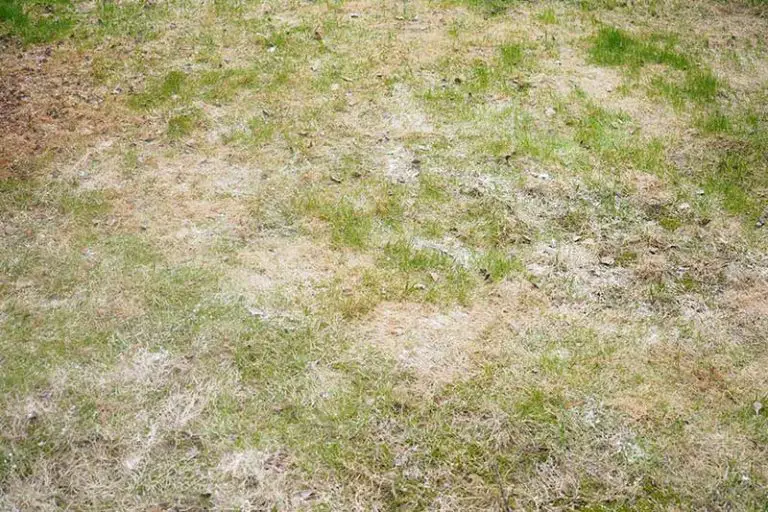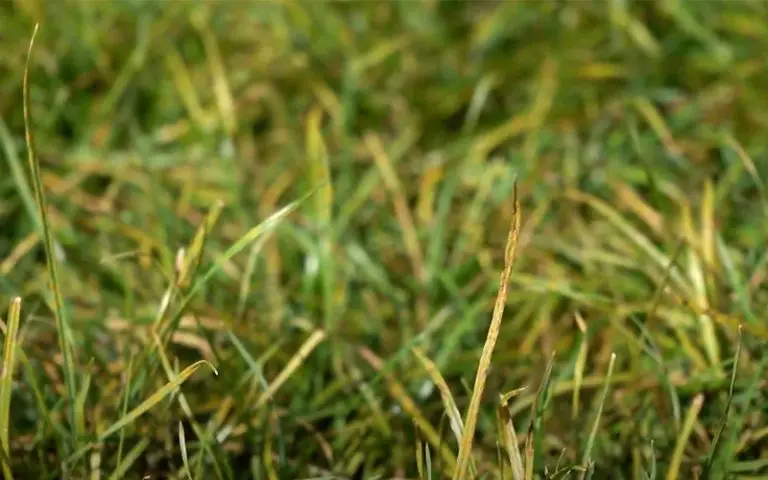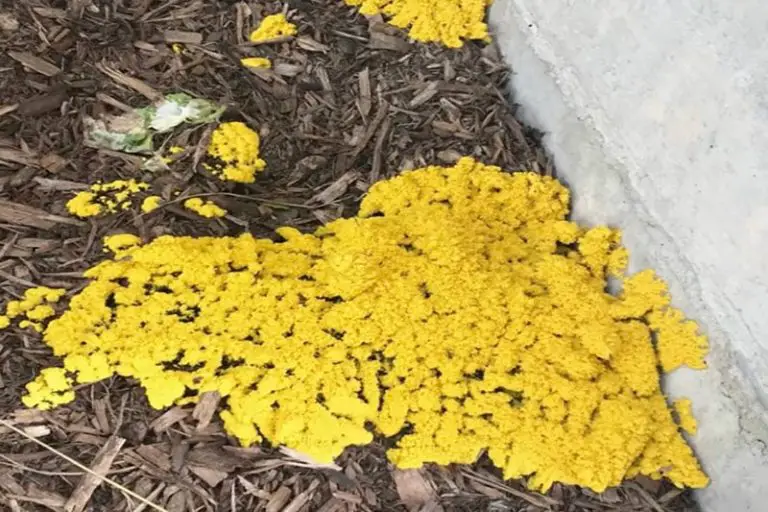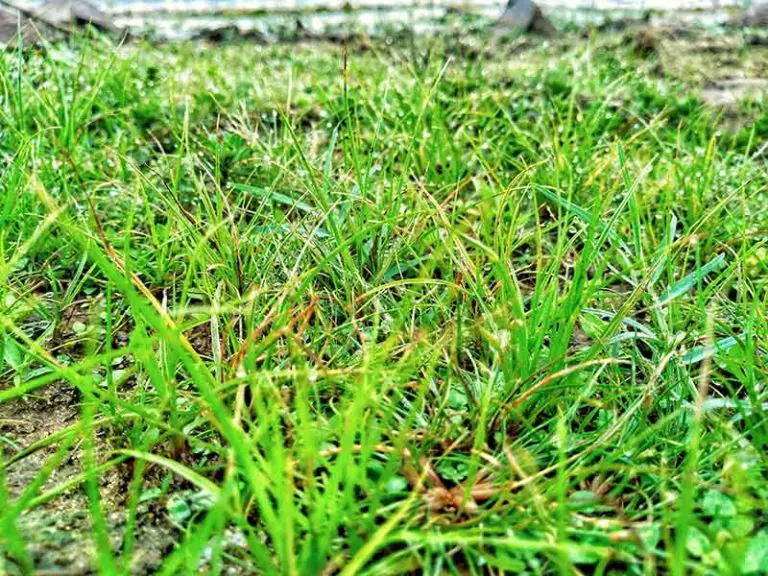Lawn Fungus: A Complete Guide to Lawn Fungus Identification and Control
A yellowing or patchy lawn can be extremely frustrating, especially when you’ve been keeping up with your usual watering and fertilization schedule. But, before you start blaming yourself, take a closer look at your unhappy grass – your lawn may be suffering from an infestation of lawn fungus.
Lawn fungus spores are present in all lawns and are a crucial part of the balance of your backyard’s ecosystem. However, when the conditions are right, harmful fungal organisms multiply and take over your soil, destroying your healthy grass along the way.
As explained in this article, there are several different types of lawn fungus that all require their own method of control. We have also detailed the measures you can take to prevent lawn fungus from returning to your backyard.
What is Lawn Fungus?
Fungus spores live in your lawn as some of the millions of microorganisms that help your grass to grow. Most types of fungi present in your lawn are actually beneficial to your grass plants; fungus spores aid the decomposition of organic matter, in turn releasing nutrients into the surrounding soil. The nutrients are then available to be taken up by the nearby plants and grass as nourishment.
However, alongside the many beneficial organisms in your lawn are several harmful and disease-causing fungal organisms. When the conditions of the soil cause the spores to multiply, i.e. as a response to changes in the soil temperature and moisture content, it can cause the development of lawn disease that gradually decimates your healthy grass plants.
What Causes Lawn Fungus to Develop?
Lawn fungus will develop when the conditions in your yard are warm and damp. When water stays on the grass for too long, the fungus uses it to travel from leaf to leaf of the grass blades.
The other main contributing factor to the development of lawn fungus is undernourished or unhealthy grass. When grass is in suboptimal condition, it is less able to fight off disease and fungal infestations. On top of this, there are a few more factors that can contribute to the development of fungus on your lawn.
The most common issues that cause lawn fungus to develop are:
- Underwatering
- Overwatering
- Drought
- High temperatures and/or high humidity
- Mowing the grass too short
- Using the wrong type of fertilizer for your lawn
- Using too much fertilizer on your lawn
- Having compacted soil
How Does Lawn Fungus Spread?
As we’ve just mentioned, lawn fungus spreads through a lawn via water when temperatures are warm enough for the fungi to multiply. The vegetative part of the fungus, called the mycelia, uses water to travel from one part of your lawn to another. Fungal spores are also spread primarily by the wind carrying them to other parts of your yard.
It’s for these reasons that you should avoid walking on a lawn infested with lawn fungus; you may inadvertently spread it throughout your lawn on the bottom of your shoes after walking over a diseased patch. The same goes for mowing the lawn when you have a fungal infestation, as infected grass clippings can spread the fungus even further.
Will Lawn Fungus Go Away On Its Own?
No, the majority of lawn fungus diseases will not go away on their own if you neglect to carry out lawn fungus control and prevention practices.
You need to treat fungal infestations as soon as you notice them; if not, the fungus will spread and take over your lawn, destroying your healthy grass as it goes. Once you have treated the problem, you must then follow the preventative measures outlined later in this article to prevent the disease from returning.
Typical Signs of a Lawn Fungal Infestation
In general, the typical signs of a fungal infestation include:
- Rings of white, yellow, or brown patches of grass that expand in diameter
- Patches of grass blades that are frayed, distorted, or off-color
- Patches of grass that appear dead or yellowed
- Stems and/or blades of grass have black, gray, orange, red, or purple spots
- Grass blades have powdery or threadlike coatings of gray, black, or pink
- Patches of grass that are darker than usual and appear wet, slimy, or greasy
It should be noted that many of the symptoms of fungal infestations are similar to those of fertilizer burn, which is the damage caused by overfertilizing with too much nitrogen. Make sure you aren’t dealing with this issue before attempting to treat the lawn with a fungicide.
The exact signs that your lawn has a fungal infestation will vary depending on the type of lawn fungus you’re dealing with; we explain this further in the next section.
Types of Lawn Fungus and Identification Pictures
There are many different types of lawn fungus. While a lot of the various types of lawn fungus share similar symptoms and features, they are different diseases that require different treatments to best tackle them.
We have gone through several of the most common types of lawn fungus and their treatments below.
Brown Patch Fungus
Brown patch lawn disease is one of the most common fungal lawn diseases. Caused by the Rhizoctonia fungi, brown patch fungus is at its worst when evening temperatures reach between 65 to 70°F. This lawn fungus affects cool-season grasses and some types of warm-season grasses.
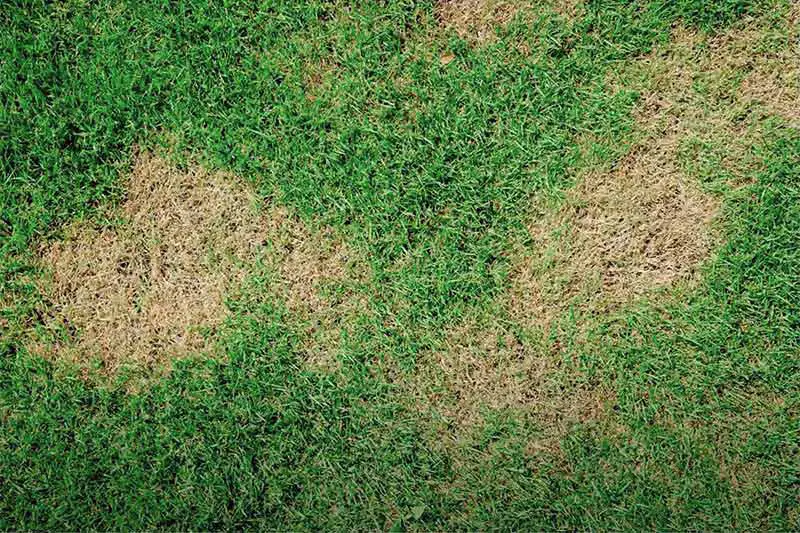
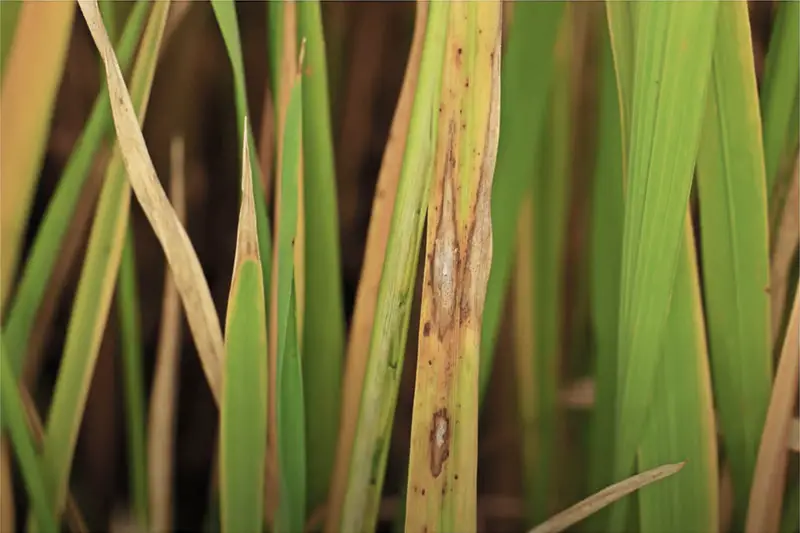
Identification
Brown patch lawn disease appears in a lawn as large patches of dry or dead grass. The patches are circular, having either regular or irregular borders of a darker color. The patches start relatively small before quickly expanding as the fungus spreads, with patches measuring up to 3 feet in width.
Treatment
The best treatment for brown patch lawn disease is to use a fungicide that is specially formulated to combat Rhizoctonia fungi. We recommend using a fungicide with fludioxonil as the main ingredient to get rid of brown patch fungus in your lawn.
Prevention
To prevent brown patch lawn disease from returning, you should take care when fertilizing and watering your lawn; overzealous fertilization and watering will enable the brown patch fungus to spread more quickly.
Summer Patch Fungus
Summer patch lawn disease is caused by Magnaporthe poae fungi. As the name suggests, this lawn fungus develops in the late spring to early summer. It mostly affects lawns with cool-season grasses, but may show up on warm-season grasses too. It’s likely that you won’t notice summer patch lawn disease until later in the summer when it starts to cause the most significant damage to your grass.
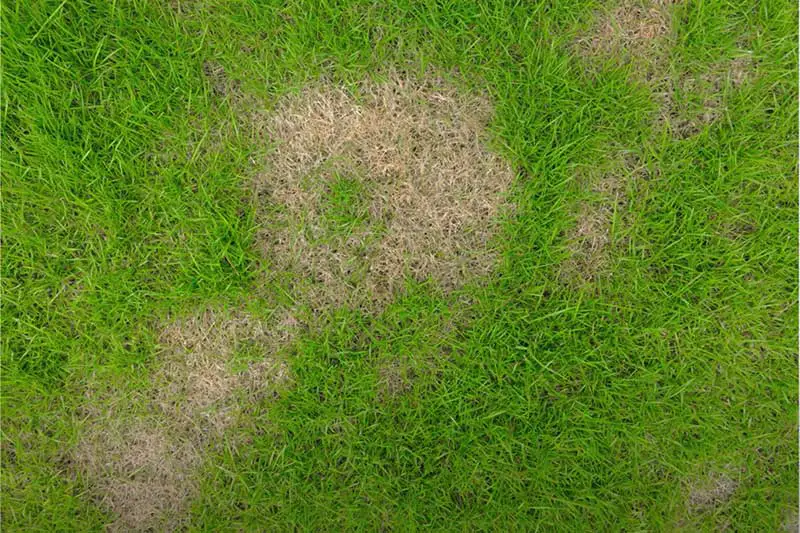
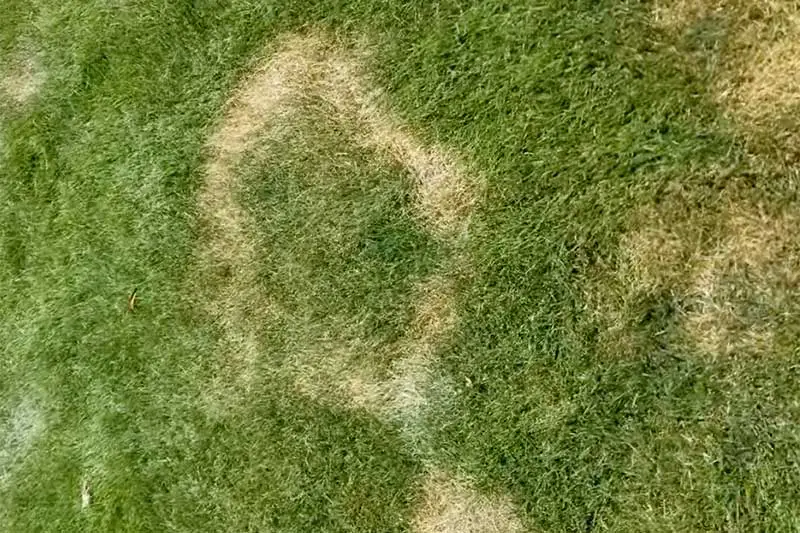
Identification
You can identify summer patch lawn disease in its early stages by looking for 2-inch wide patches of wilted, dark-green grass. As the patches grow, the grass will start to turn yellow or brown in color. With summer patch, the grass plants tend to die off starting from the top of the tip of the blade.
Treatment
Unfortunately, by the time you notice summer patch lawn disease, it’s already too late to treat it with chemicals. You won’t be able to treat this disease with post-emergent herbicide even if you catch the fungus in its early stages of development. At this point, the only measure you can take to prevent the spread of the fungus is to maintain the health of your lawn. This will help your grass recover once the fungus subsides.
Prevention
You can apply a pre-emergent fungicide to prevent summer patch lawn disease from developing the following season. Choose a fungicide that contains propiconazole as its main ingredient. You should apply the fungicide either in the late spring, or when temperatures in your area reach 65°F.
Dollar Spot Fungus
Dollar spot is a common lawn disease caused by the Sclerotinia homoeocarpa fungus. This lawn fungus is most active during the summer months and can leave your grass with long-lasting damage. Dollar spot fungus primarily affects lawns with centipede grass, perennial ryegrass, and fine fescue. It can also damage tall fescue, Kentucky bluegrass, bermudagrass, and zoysiagrass.
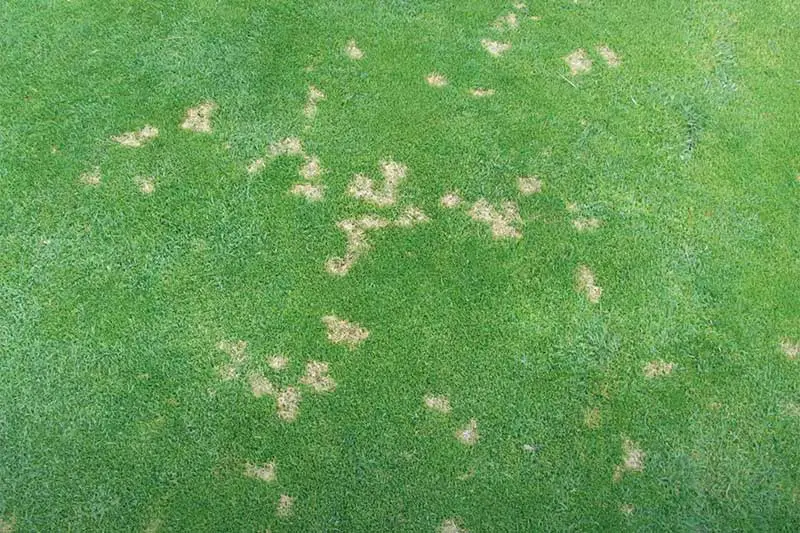
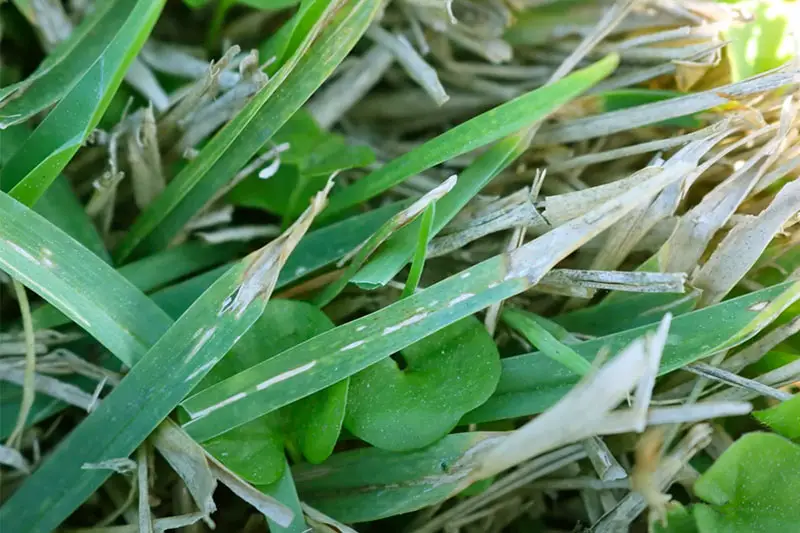
Identification
Dollar spot fungus appears in lawns as rings of tan-colored grass that measure roughly an inch in diameter. The spots often form in small clusters across the lawn. If you observe the spots in the early morning, you may be able to see downy patches of mycelia.
Treatment
The best way to treat dollar spot fungus is with the application of a high-nitrogen fertilizer. Apply the fertilizer once in the fall, then again around mid-summer. As a general rule, you should apply the fertilizer at a rate of 0.2 pounds per 1000 square feet of your lawn. It is possible to treat dollar spot with fungicide, however, this is best carried out by a lawn care professional.
Prevention
To prevent dollar spot from returning, you should carry out general lawn care practices regularly. When watering your lawn, aim to water less frequently but more deeply to encourage your grass plants’ deep root growth. Remember to aerate your lawn annually and keep up with a sufficient fertilization schedule. When mowing, always use sharp mower blades and don’t leave grass clippings behind on the grass (try composting them instead).
Necrotic Ring Spot
Necrotic ring spot is caused by the Ophiosphaerella korrae fungus. This lawn fungus tends to develop in spring or fall when the weather is cool and wet. It can be extremely damaging to lawns with any grass type, but is particularly devastating on lawns growing Kentucky bluegrass. Necrotic ring spot fungus kills grass by destroying the root systems of your lawn as it feeds on organic matter in the surrounding soil.
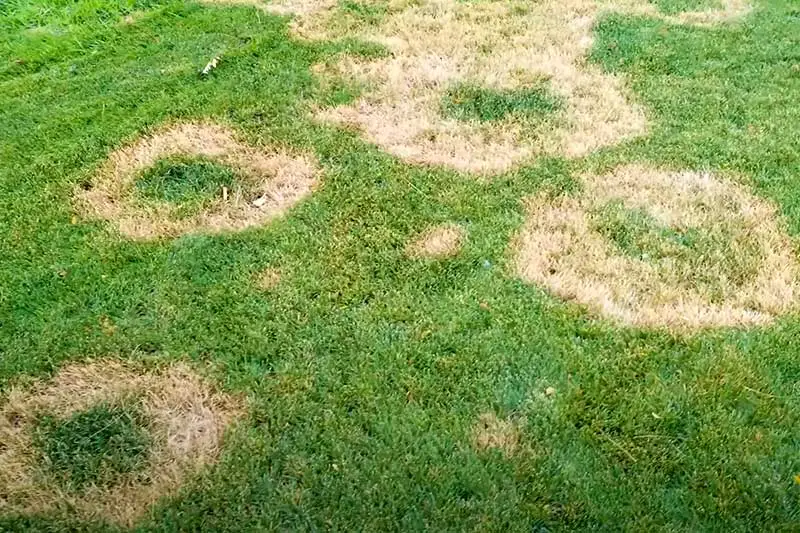
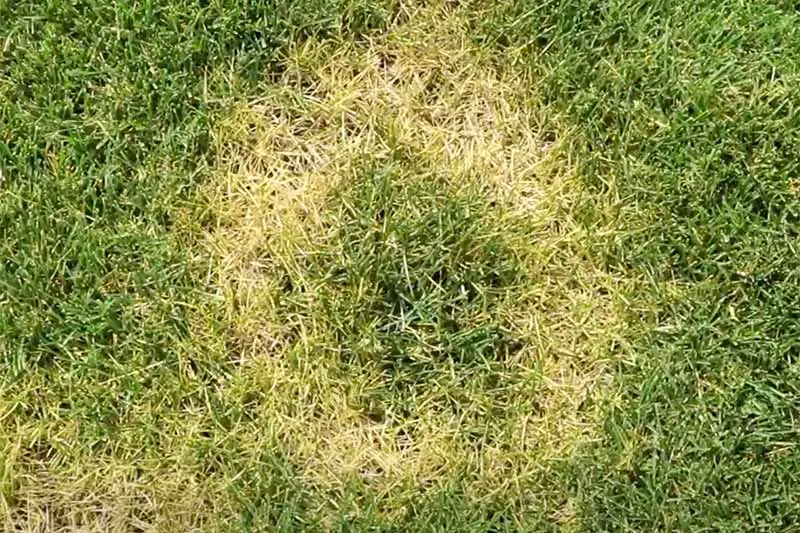
Identification
In its early stages, necrotic ring spot will cause patches of grass to fade to a light-green to yellow color. The patches measure 3 to 15 inches in diameter, sometimes reaching up to 3 feet wide. The affected patches of grass will then start to thin out. You can identify this lawn fungus by the distinctive shape of the patches; they are ringed, appearing similar to a frog eye. After this pattern develops on the lawn, the grass in the affected areas will ultimately die off.
Treatment
A variety of fungicides are suitable to treat necrotic ring spot, such as those containing thiophanate-methyl, fenarimol, or propiconazole. The key to eliminating necrotic ring spot with fungicide is careful timing; you must apply it when the fungus is most active, i.e. when soil temperatures reach between 60 to 70°F. This fungicide will be most effective when applied directly before or after watering the affected area.
Prevention
The best method to prevent necrotic ring spot is to keep up with regular lawn maintenance practices. This involves aerating your lawn frequently to encourage the deep growth of your grass plants’ root systems, in addition to keeping up with a proper watering and fertilization schedule. When fertilizing your lawn, you should use an organic and high-nitrogen fertilizer to encourage the growth of strong, disease-resistant grass plants.
Pythium Blight
Pythium blight is a lawn disease caused by a number of fungi in the Pythium family, such as Pythium aphanidermatum, Pythium graminicola, and Pythium ultimum. This lawn fungus primarily affects cool-season grasses when conditions are at their hottest and most humid over summer. Pythium blight is also referred to by the names cottony blight, spot blight, or grease spot.
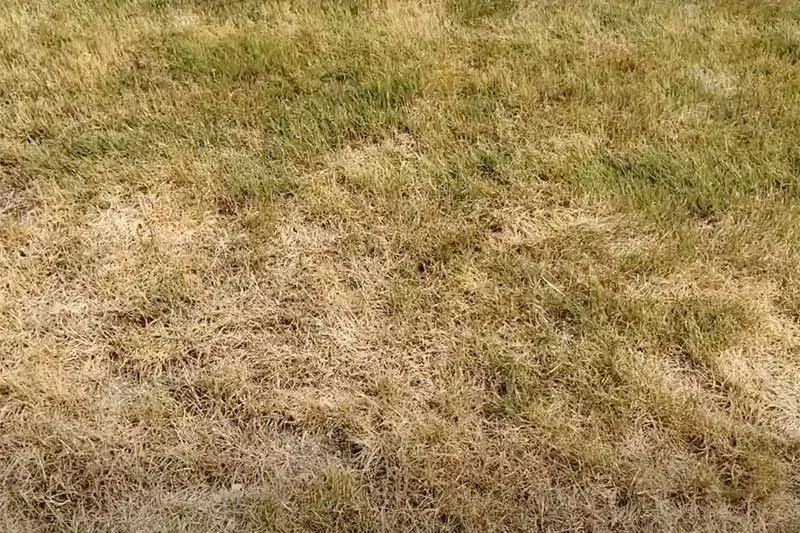
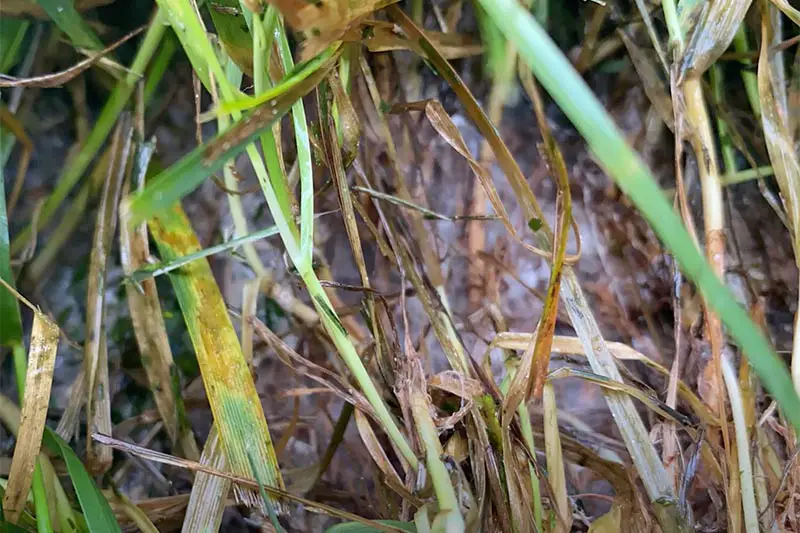
Identification
When the Pythium fungus first starts to develop, Pythium blight will appear as orange-colored spots on your lawn. The spots measure at about 1 to 3 inches in diameter and occasionally some may appear to have outer rings of light gray in the early morning. Under a sustained high level of humidity, these spots will begin to develop fluffy patches of cobweb-like mycelium.
Treatment
To treat Pythium blight in your lawn, you should purchase a fungicide containing the ingredient mefenoxam.
Prevention
To prevent Pythium blight from returning, you can use the same fungicide containing mefenoxam as a preventative fungus control product. Reapply the fungicide every 10 days, or as per the instructions on the label of your chosen product.
Lawn Rust Disease
Lawn rust disease is a common disease caused by several different types of lawn fungus. This disease develops when temperatures reach between 68 and 86°F, which is typically some time between spring and fall. Rust disease takes over in rainy, wet weather conditions, but it may also develop during a sunny spell that follows a period of wet and humid weather. It can affect grass of any species, but most often affects ryegrass, tall fescue, zoysiagrass, and Kentucky bluegrass.
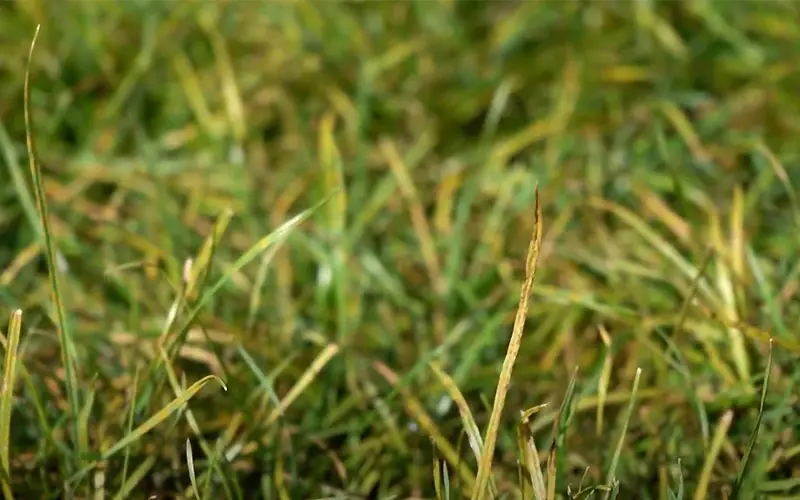
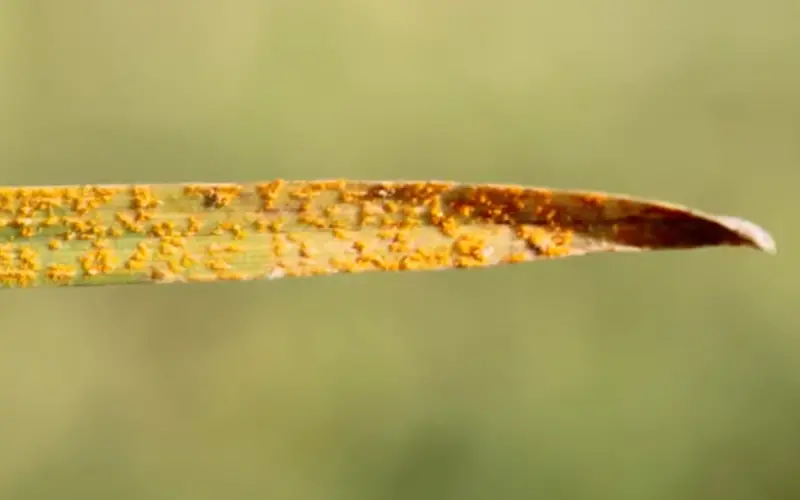
Identification
You can identify lawn rust disease by looking for irregular-shaped patches of yellow grass on your lawn. Looking more closely at grass with lawn rust disease, you should see small yellow flecks on the grass blades. As the disease develops, these yellow flecks will begin to rupture, releasing a light-yellow powder that will rub off onto your shoes and clothes.
Treatment
You should first turn to non-chemical lawn maintenance practices to try and treat lawn rust disease. Follow a proper watering and fertilization schedule for your lawn and environmental conditions. If the grass hasn’t shown signs of improvement after about three weeks, you will need to apply a fungicide; choose a product containing the ingredient propiconazole. Take note that you should only use fungicides as a last resort for severe infestations of lawn rust, and you must apply them before the fungus goes dormant for winter.
Prevention
Keeping a thick lawn full of healthy grass is one of the best methods to prevent lawn rust disease. Keep up with a regular fertilization schedule, using a high-nitrogen organic fertilizer to boost the strength of your grass plants. Watering properly and aerating your lawn will also help to prevent this lawn disease. Also, try to minimize shaded areas of your lawn where possible.
Red Thread
Red thread lawn disease is caused by the Laetisaria fuciformis fungus. This lawn fungus thrives in areas where the climate involves warm daytime temperatures followed by cool, moist evenings; for this reason, red thread lawn disease is most common in the northern states of the US. This fungal disease doesn’t actually harm your grass directly. However, it leaves the lawn more susceptible to stress from other diseases and pests, which in turn damages the grass.
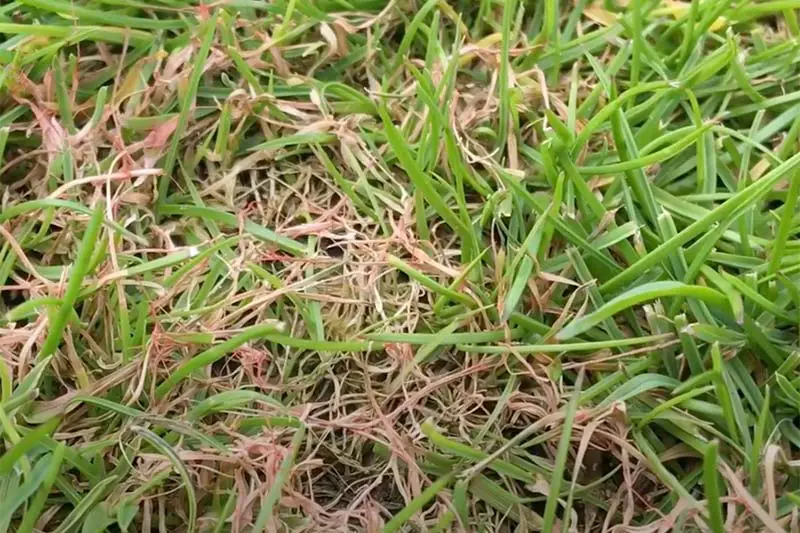
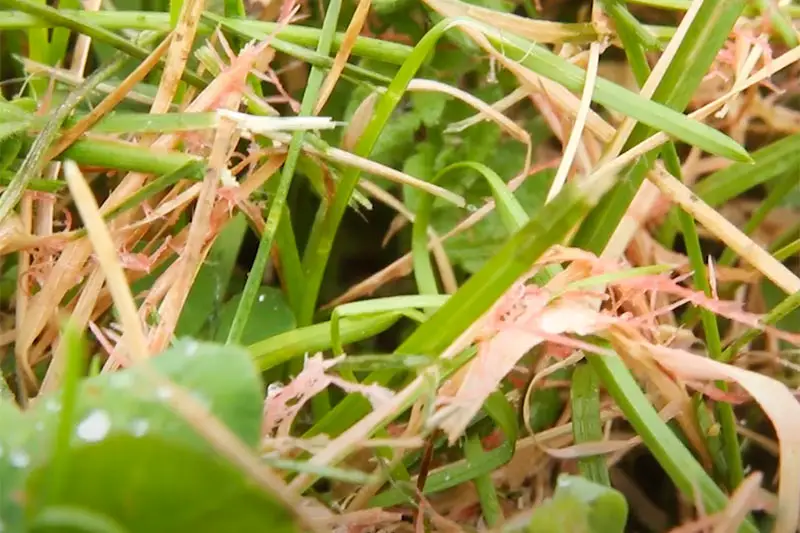
Identification
It’s relatively easy to identify red thread disease on a lawn. From a distance, patches of grass affected by the disease will have a reddish hue. On closer inspection of the patches, you may be able to see the fungus’ red strands among the grass blades. The grass blades themselves will be yellowing or bleached of color. The affected patches of grass typically measure up to 2 feet in diameter.
Treatment
You should try non-chemical methods to treat red thread fungus before attempting to use a fungicide. This involves strengthening the health of your existing lawn by aerating your soil and following a regular fertilization schedule; choose an organic, high-nitrogen fertilizer for best results. Doing so will eliminate the red thread from your lawn after about 2 years.
Chemical treatments to eliminate red thread lawn disease are only suitable for very severe infestations of the lawn fungus. Fungicides designed to combat red thread lawn disease contain chemicals called strobilurins; these fungicides are typically limited to professional usage only.
Prevention
To prevent red thread from returning, you should keep up with regular lawn care practices like watering, fertilization, and aeration. As red thread thrives in low-nitrogen soil, remember to fertilize your lawn with a high-nitrogen fertilizer. You could also overseed your lawn with a more disease-resistant grass type, such as bluegrass or perennial ryegrass.
Pink Snow Mold
Pink snow mold is caused by the Micodochium nivale fungus. Despite the name, pink snow mold doesn’t need snow to develop, nor is it consistently pink. It will thrive in lawns where the conditions are cool and humid, potentially growing all year round depending on the temperatures of the area it’s in.
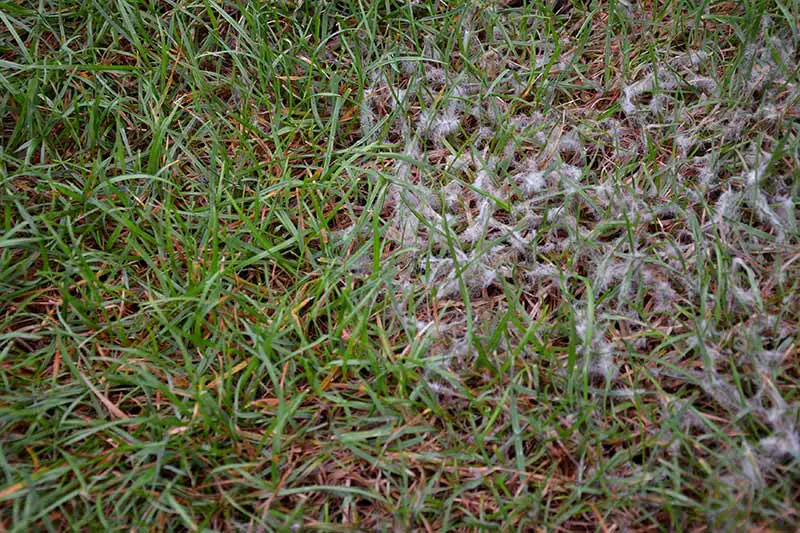
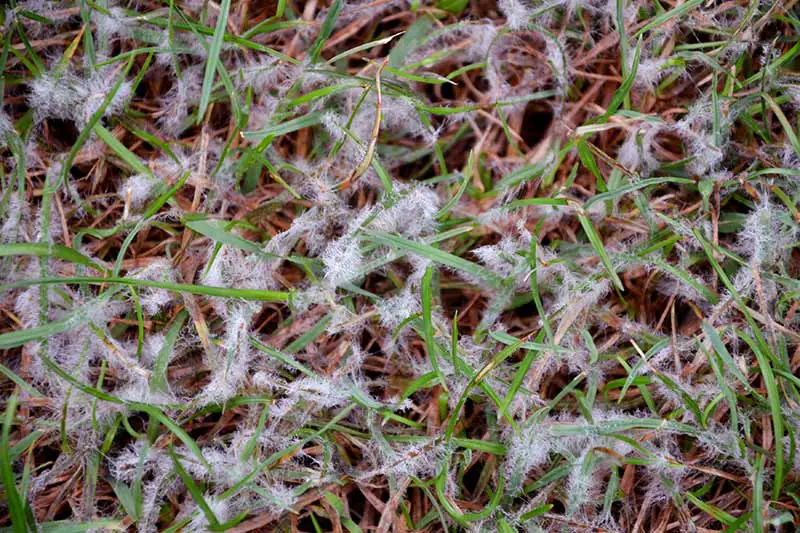
Identification
A lawn that is infested with snow mold will turn straw-colored, and the grass may become matted. The fungus forms a cobweb-like coating called mycelium which can be pink or white in color. This typically develops in the early spring after the last of the snow has melted, however, it can happen any time of the year that the conditions are right. The affected spots will shrink as temperatures rise.
Treatment
Pink snow mold will go away on its own when temperatures are warm enough, leaving your grass to regreen soon after. You can speed up your grass’ recovery process by raking the affected area of the lawn gently before leaving it to dry out. When the grass dries and you’ve mowed it a few times, you should dethatch the lawn. Continue by mowing at a height shorter than usual until the mold abates completely.
Prevention
If you have to deal with pink snow mold every year, try tackling it before it has the chance to develop using a thiophanate-methyl fungicide. Apply this type of fungicide to your lawn before the first snow is forecast as this will prevent the growth of the fungus when the snow melts in the early spring.
Gray Snow Mold
Gray snow mold differs from its aforementioned pink counterpart as it is caused by species of fungi in the Typhula family. This lawn fungus also thrives when the weather is cool and humid, growing with or without the previous presence of snow.
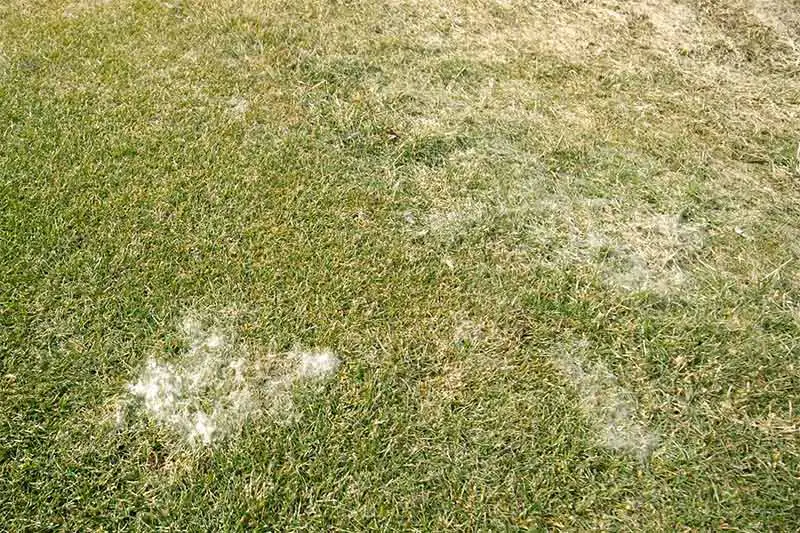
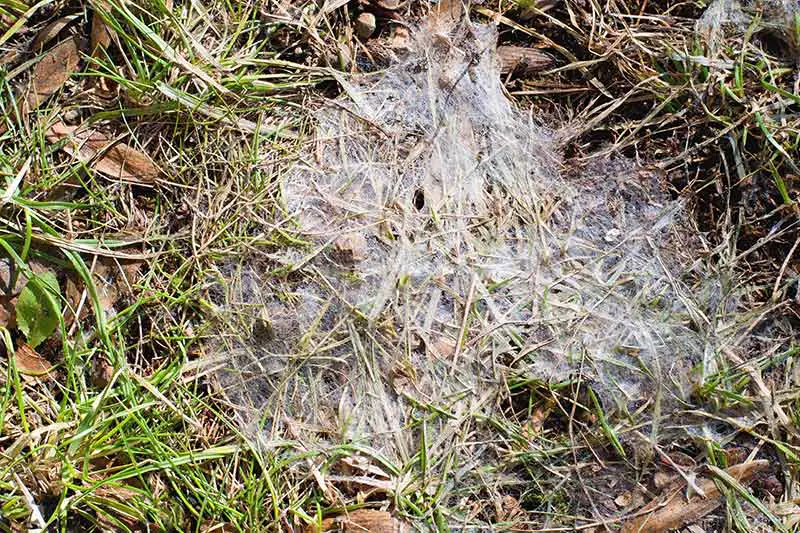
Identification
Gray snow mold causes patches of strawlike or gray-colored grass that measure about 6 to 12 inches in diameter. This disease also forms a cobweb-like coating called mycelium that matts down the healthy grass on your lawn. You can tell gray snow mold apart from pink snow mold by the color of this mycelium, as it will take on more of a grayish hue.
Treatment
Gray snow mold will go away on its own once temperatures warm up and the grass has a chance to fully dry out. As is the case with pink snow mold, you can speed up this process by lightly raking the affected areas to aerate the turf, mowing the lawn as usual. Once the grass is dry enough, dethatch the lawn and continue to mow on a shorter setting than usual until the mold has subsided.
Prevention
Use a fungicide containing thiophanate-methyl to prevent gray snow mold from returning next season. Apply the fungicide to your lawn before the first snow is forecast in winter.
Powdery Mildew
Powdery mildew is caused by the Bluemeria gramanis fungus. It is an incredibly non-discriminatory lawn fungus, affecting all types of grasses as well as nearly every other type of plant. Powdery mildew thrives when weather conditions are warm and wet, making it particularly prevalent in the southeastern US states. While this type of lawn fungus isn’t overly destructive to grass, it is one of the more unsightly infestations you could have in your yard.

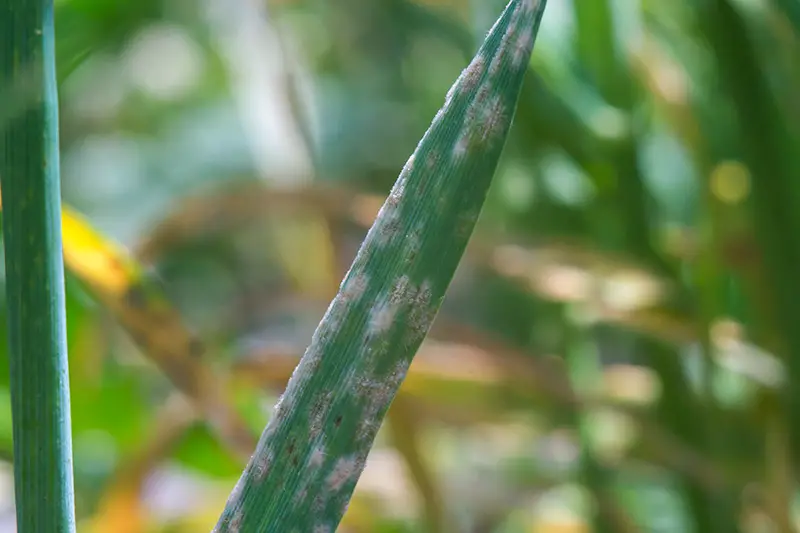
Identification
It is extremely easy to identify powdery mildew as it appears like no other type of lawn fungus. Grass (and other plants) suffering from this disease will be covered in white or grey powdery spots.
Treatment
As this lawn fungus won’t cause too much harm to the health of your grass plants, treatment isn’t strictly necessary. Despite this, you will likely want to treat the disease regardless as it causes the grass to have such an unappealing appearance. You can use a number of fungicides to treat powdery mildew; this includes those containing propiconazole, myclobutanil, metconazole, tebuconazole, triticonazole, or triadimefon.
Prevention
The key to preventing the development of powdery mildew on your lawn is to reduce areas of shade and improve the airflow in your yard. Keep trees and shrubs around your yard pruned as short as possible, removing them completely if possible. Avoid using too much high-nitrogen fertilizer on the shadier parts of the lawn, as this will overfertilize the grass. Also, you should water these areas less frequently, always watering in the morning rather than the evening.
Fairy Rings
Fairy rings are caused by over 40 different species of lawn fungus. For this reason, fairy rings can appear on lawns that contain grass of any species. This lawn disease thrives throughout most of the year, from spring to fall. Fairy rings fall under one of three categories, either being Type I, Type II, or Type III. It is only Type I that can cause severe lasting damage to the grass plants on your lawn; this type causes the soil and thatch layer to become water-repellant, in turn causing patches of the turf to die off completely.
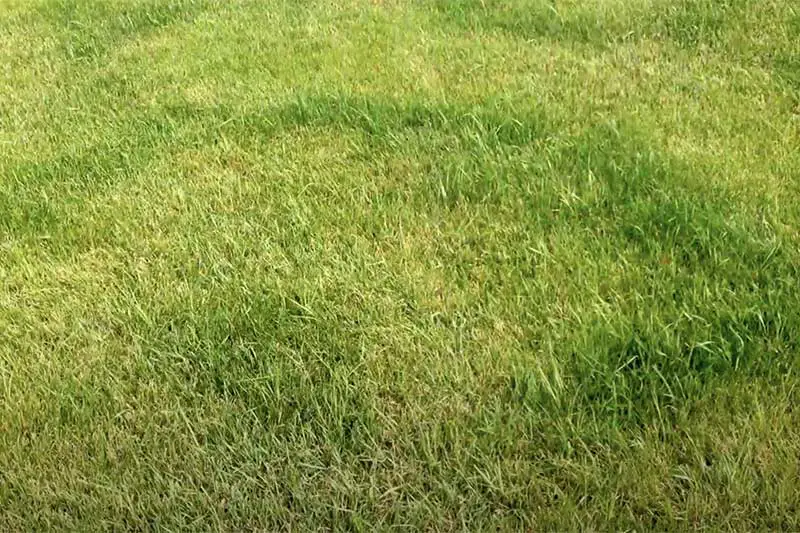
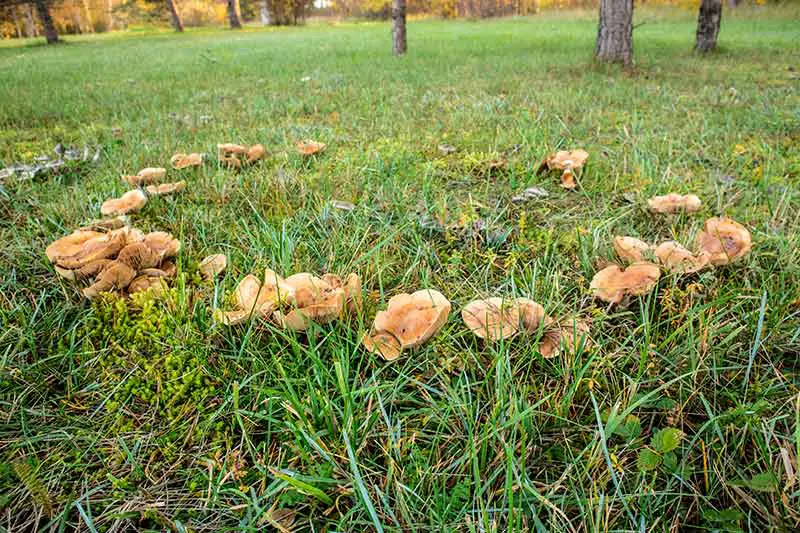
Identification
Type I fairy rings appear as large, irregular rings throughout the grass, ranging in color from dark green to tan. The rings are made up of a circle of dead grass bordered on either side by strips of overstimulated growth, and there may be mushrooms or toadstools growing along the rings. The soil and thatch layer in a Type I fairy ring will be extremely dry.
Type II fairy rings appear as dark green rings of overstimulated grass growth. There may or may not be mushrooms or toadstools growing along the rings.
Type III fairy rings typically have no visible ring of overstimulated grass growth. They are only evident by the ring of mushrooms or toadstools that they grow.
Treatment
Fairy rings can be difficult to treat as they have an impact on both the grass and soil. Firstly, you should aerate the affected area thoroughly, doing so to a distance of up to 3 feet beyond the edge of the rings. You should then apply a wetting agent to the affected area; this helps to reduce the hydrophobic effect that the fungus has on the surrounding turf. Water your lawn every day for about 5 to 10 days until the grass starts to repair itself. After this, you can strengthen your existing grass by applying a high-nitrogen fertilizer to encourage regrowth. Alternatively, you could reseed the lawn entirely, or install a new lawn from sod.
Prevention
You can prevent fairy rings from cropping up on your lawn by removing the organic matter that the ring-causing fungi like to feed on. This primarily involves regularly dethatching your lawn, in addition to removing other sources of decaying organic matter like old tree stumps and freshly-mown grass clippings.
Leaf Spot
Leaf spot is the name given to a range of similar diseases caused by bipolaris, drechslera, and exserohilum fungi. A range of grass types are susceptible to leaf spot diseases, however, they are most prevalent in Bermudagrass and bluegrass. The damage caused by leaf spot is only superficial at first; however, when the disease develops, it eventually leads to rotten turf and dead grass.
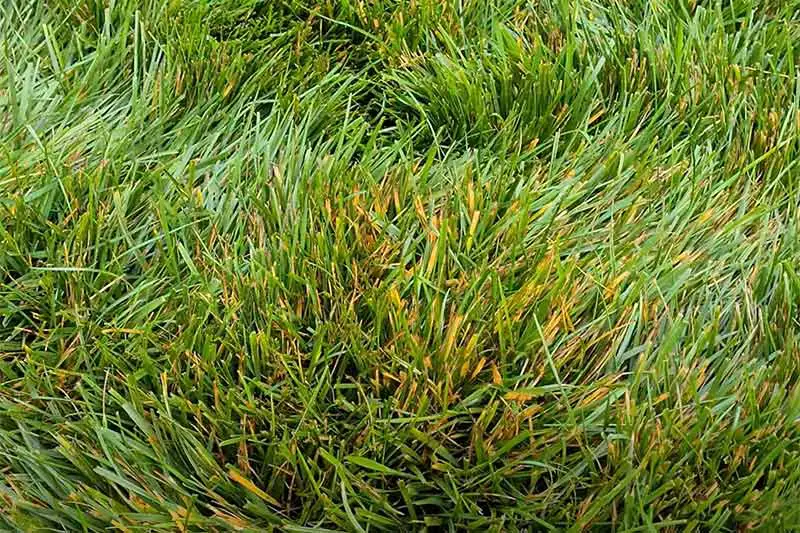
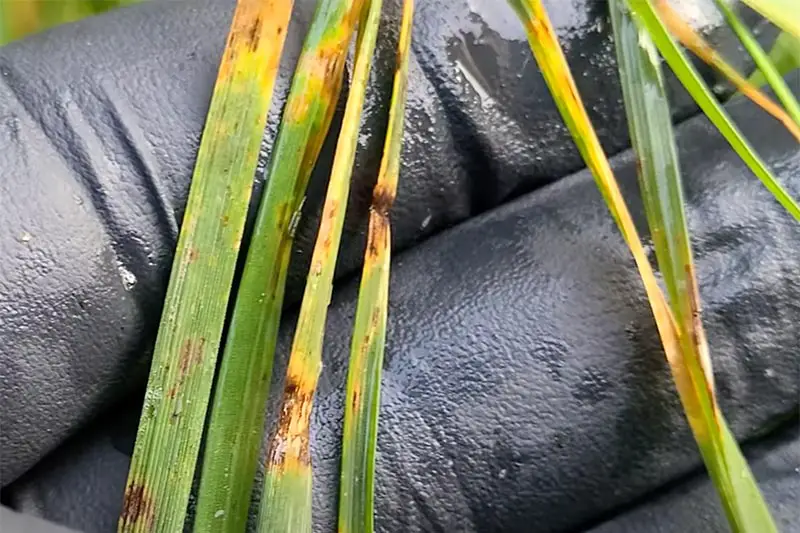
Identification
The blades of grass affected by leaf spot are covered in brown spots, easily mistaken for pest or drought damage. As the disease develops, it will gradually cause the grass to change color from reddish-brown to yellow. After this point, the blades will start to wilt and die off.
Treatment
You can use a chemical fungicide to treat grass suffering from leaf spot. The best products to use for this purpose are strobilurins or ‘Qol’ fungicides, or those containing the ingredient iprodione. As there are heavy regulations on the use of these types of fungicide, you may need to seek the assistance of a lawn care professional.
Prevention
Non-chemical methods to prevent leaf spot involve taking care of your grass’ health. You can do this by mowing your grass to the best height for its species and keeping up with a regular fertilization schedule.
Gray Leaf Spot
Gray leaf spot is caused by the fungus Pyricularia grisea. This lawn fungus primarily affects St. Augustine grass, but can also affect perennial ryegrass, annual ryegrass, and tall fescue.
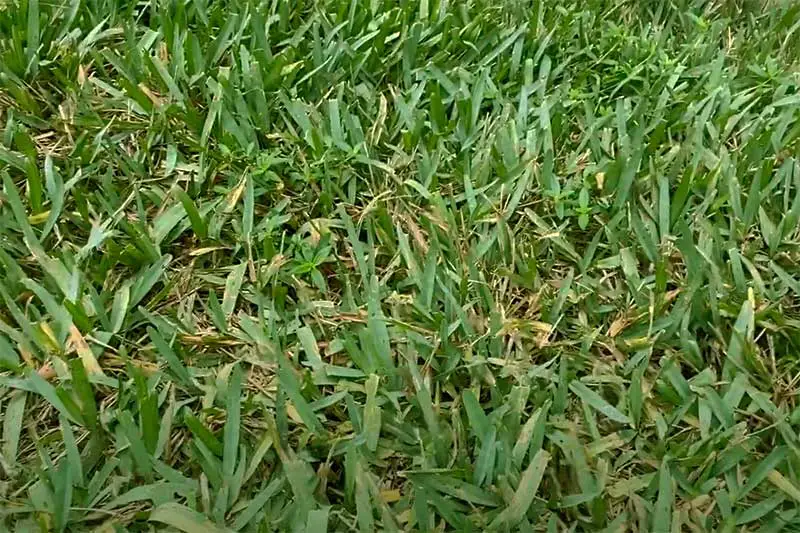
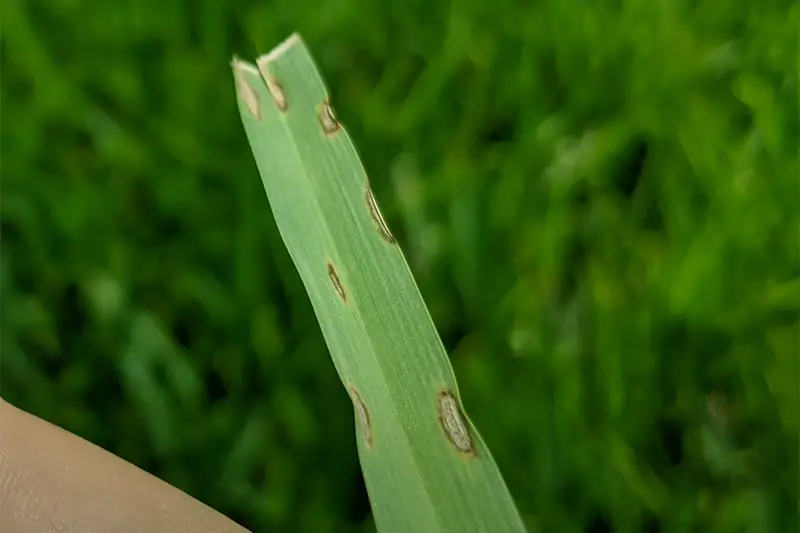
Identification
On St. Augustine grass specifically, gray leaf spot will appear on grass blades as gray or tan spots bordered in purple or brown. The spots are depressed in their center.
For other types of cool-season grasses, gray leaf spot can be harder to identify. Instead of the disease’s distinctive spots, the grass blades will have lesions the size of pinpricks. If the disease is left untreated, the lesions develop causing the blades to have dead, twisted leaf tips.
Treatment
The first line of attack when treating gray leaf spot is to keep up with regular routine lawn care practices. Follow a proper watering and fertilization schedule, monitoring the affected areas for signs of improvement.
If necessary, you can treat the infestation with a chemical fungicide. Choose a product that contains azoxystrobin, pyraclostrobin, or fluoxastrobin. Take note that these chemicals will only work to treat the problem temporarily (for up to 28 days). For severe or recurring infestations of gray leaf spot, it’s best to leave the treatment to a professional.
Slime Mold
Slime mold is a fungal infestation caused by the fungi in the Mucilaga or Physarum family. While this disease isn’t necessarily harmful to the health of your grass, it is unsightly in appearance.
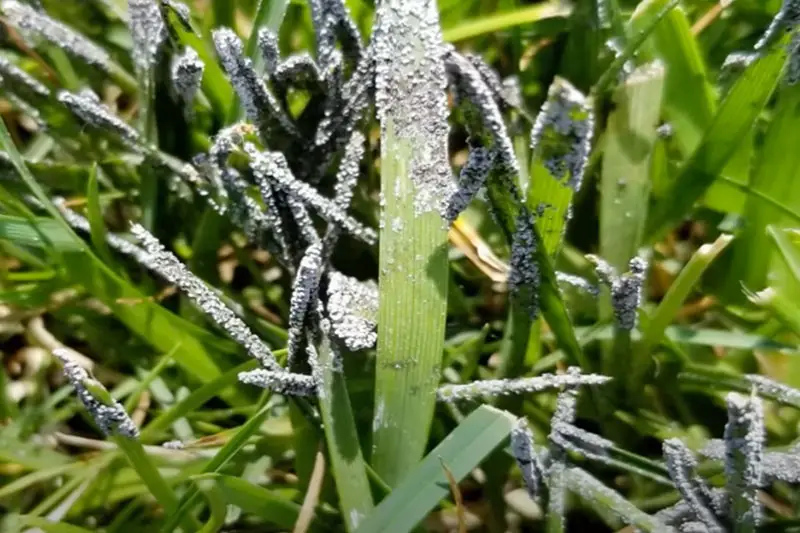
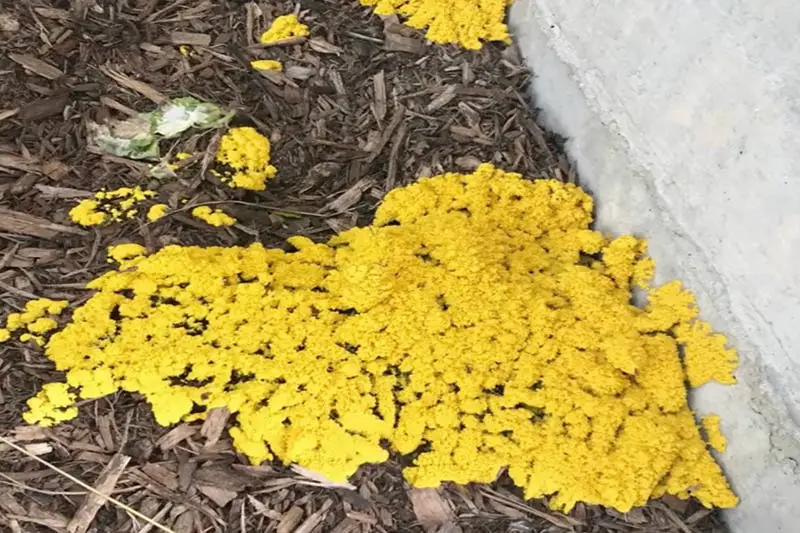
Identification
Slime mold is relatively easy to identify on a lawn, but there are different types that manifest in slightly different ways. For instance, you can identify one type of slime mold fungus by the greyish slimy substance that it coats the affected grass blades in. If you look at grass affected by this type of slime mold from a distance, it can appear as though the grass is covered in ashes.
Another variation of slime mold presents itself as blobs of a yellowish substance that almost looks like dog vomit. As this fungus develops, the yellowish substance turns powdery and grey in color.
Treatment
Slime mold will eventually go away on its own, leaving no lasting damage to your grass. If you’d like to speed up the process, rake the affected area or use moderate water pressure to spray it off the grass.
Prevention
The best way to prevent slime mold from developing in your lawn is to reduce the humidity of your soil. You can do this by watering in the morning instead of in the evening. You can further your lawn’s protection against slime mold by regularly aerating the soil.
How to Prevent Lawn Fungus From Taking Over Your Lawn
Mindful fertilization, watering, mowing, and soil testing are all key practices to having a healthy lawn full of disease-resistant grass. Keeping up with these regular lawn care practices will help you to rid your grass of lawn fungus for good.
Aerate Soil
You should aerate your soil to eliminate areas of compacted soil that encourage the development of lawn fungus. Compacted soil can contribute to fungal infestations in two ways; firstly, grass has a hard time growing in condensed soil, leading to weak and unhealthy grass plants; secondly, compacted soil creates drainage issues, creating the ideal damp conditions for lawn fungus to grow.
If you’d like to DIY the job, aerate your soil following the guidance in our article How to Aerate a Lawn. This involves using a spike aerator or core aerator to create holes throughout the soil. Alternatively, you could contact a landscape company to carry out the job instead.
Dethatch Lawn
Dethatching your lawn is important for the general health of your grass, in addition to improving its resistance to lawn fungus. Thatch is a layer of matted organic matter that builds up between the surface of the soil and the top of the grass blades. This layer chokes out the healthy, growing blades, leaving the grass more susceptible to infestations of lawn fungus. Dethatching involves the removal of the thatch layer using a manual or powered dethatching rake.
Although it is a time-consuming process, you can dethatch your lawn yourself. For smaller lawns, a manual dethatching rake will do, but if you’re working on a larger lawn you may need to rent a powered dethatching rake from your local garden center. If you’re the owner of a ride-on mower, you could alternatively purchase a dethatching attachment.
Add Top-Dressing
You can improve your lawn’s overall health and prevent lawn fungus infestations by adding a top-dressing. This enables better drainage of the soil, in addition to encouraging the growth of healthier, stronger grass plants. Both of these benefits increase the lawn’s resistance to lawn fungus.
Top-dressing a lawn involves adding a layer of rich, organic matter such as compost to the surface of the soil. Apply your chosen top dressing in a layer of about ¼ inch thick and rake it into the soil. Make sure not to spread the layer so thick that it smothers the growing grass plants.
Conduct Soil Tests and Amend Soil
You should monitor the pH and nutrient levels of your soil by testing it and amending it where necessary. Although it varies species-to-species, most grass types thrive in soil that has a pH between 6 and 7. Outside of this range, grass will struggle to grow healthily. The same can be said for grass growing in soil with insufficient nutrients, particularly the primary nutrients of nitrogen, phosphorus, and potassium.
You can either send a sample of your soil for testing in a professional lab, or you can conduct a DIY soil test at home. The results of the soil test will reveal what fertilizer or pH adjusting materials you may need to add to keep your soil in the best condition for your grass type.
Use Fertilizer in Appropriate Amounts
Both the over-application and under-application of fertilizer can encourage the growth of lawn fungus in your grass. If you don’t provide your grass with enough nutrients, it will fail to grow strong leaves and root systems. However, if you over-fertilize your lawn, your grass plants will grow too rapidly for the root system to keep up. In either case, you will end up with stressed grass plants that are highly susceptible to the development of lawn fungus.
Make sure to follow a proper fertilization schedule, using the best type of fertilizer for your grass’ needs. You can find out what type of fertilizer would be best for your grass by first conducting a soil test, as explained in the previous section. You should also make sure that the fertilizer is suitable for your specific grass type. Apply the fertilizer following the directions on the label of your chosen product.
Follow Correct Watering Schedule
Follow a proper watering schedule for your grass and climate conditions to prevent the spread of lawn fungus. By accidentally overwatering your lawn, you create the damp conditions in which fungal infestations thrive. Conversely, underwatering your lawn will leave your grass plants weak and susceptible to disease.
Typical watering requirements for most established lawns are to add about 1 to 1 ½ inches of water to your lawn, watering 1 to 2 times per week. This amount will vary based on your grass type and the weather conditions you’re currently facing. Also, the best time of day to water your lawn is in the morning. By watering your lawn at this time, you’re giving it the whole day to dry out, reducing the chances that lawn fungus will develop.
Sharpen Mower Blades
Sharp mower blades are essential for the health of your grass and its resistance to fungal infestations. When you mow with dull mower blades, the mower rips off the top of the grass leaves and leaves the plants with ragged frayed cuts. The torn blades leave the grass weak and more susceptible to the development of lawn fungus. Sharp mower blades, on the other hand, create a clean-cut, leaving the plants in optimal condition after the mow.
You should sharpen your mower blades before the mowing season begins in spring. You may need to sharpen them again before the end of the season depending on your mower usage; the typical rule is to sharpen them after every 20 to 25 hours of use.
Follow Correct Mowing Schedule
Following the best mowing schedule for your grass type is key to keeping your grass plants healthy. Instead of thinking of your mowing schedule in a temporal sense, you should plan it out based on the ideal height for your grass type, always following the ⅓ rule (explained further in the following section) when you mow.
Mow Grass to Right Height
Your grass’ resistance to lawn fungus will be reinforced by mowing it to the best height for its species. Cutting the grass too short weakens the plants and makes them more susceptible to stress from external conditions and disease. On the other hand, grass that’s too long will encourage the damp conditions that cause the development of lawn fungus.
To give some examples of the best height to cut common grass types, fescues do best when mowed to around 3 ½ inches tall; bermudagrass thrives at 2 inches tall; zoysiagrass should be mowed to about 2 ½ to 3 inches tall. As a general rule, you should never cut off more than ⅓ of the grass blades’ height per mowing session. This may mean that you have to mow more frequently during your grass’ period of most active growth, however, it will keep your grass healthy and will act as a natural form of fungus control.
Seed Lawn With Best Grass Type For Your Area
Your lawn will be in optimal condition if it’s full of grass that’s suitable for your climate, soil type, and light conditions of your yard. Choosing your species based on these conditions ensures that your lawn can combat the fungal spores native to your area.
Grass species are classed as either cool-season or warm-season grasses. As the names suggest, cool-season grasses are best suited for northern regions, while warm-season grasses are better suited for more southern climates. Identify the grass on your lawn and make sure that you’re growing the best grass type for your area. If necessary, you can reseed your lawn with a better grass species.
Improve Air Circulation in Yard
You can prevent lawn fungus from developing by improving the air circulation in your yard. Proper air circulation is crucial as most lawn fungus types develop in moist soil when the air is still. Try improving the circulation of air in your yard by thinning out any trees or shrubs.
Naturalize Problem Areas of Yard
If your lawn only suffers from lawn fungus in certain places, you could consider eliminating the problem areas by naturalizing them. This would involve planting groundcovers or flowerbeds with plants that are better suited to the conditions of these parts of the lawn.
Be Careful With Snow
Avoid walking on and compacting the snow on your lawn if you get snowfall over winter. Heavy layers of snow that get compacted in this way may lead to the development of snow molds in the following spring.

